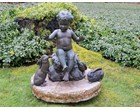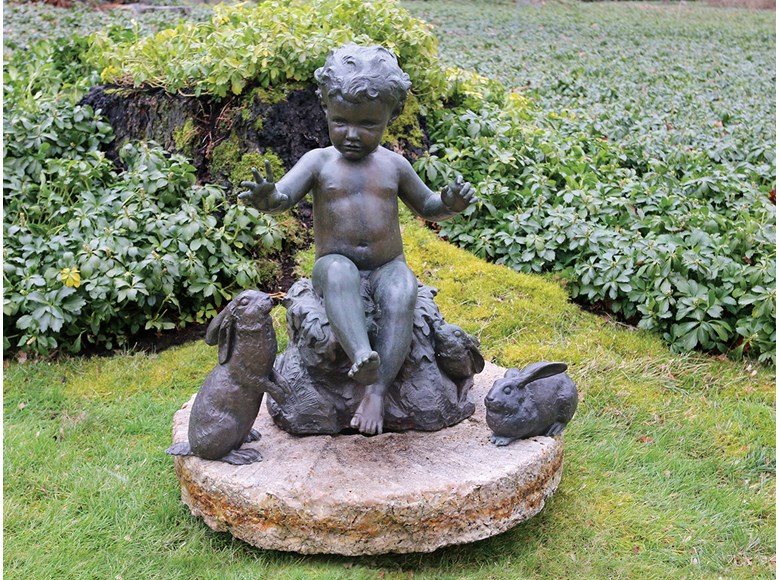 BACK TO GALLERY
BACK TO GALLERY
Barbara Israel Garden Antiques
Bronze Figural Group
Bronze Figural Group
Figure 29 ins. high, 17.5 ins. wide, 18 ins. deep; upright rabbit 12 ins. high, recumbent rabbit 10 ins. long
description
A bronze figural group by Brenda Putnam (American, 1890-1975) comprised of a cherubic young child, unclothed, seated on a rock with hands in mid-motion, as if while speaking, the child seeming to be in conversation with two rabbits, separately cast without foundry mark, one seated upright and the other recumbent, the rocky base also with integrally cast rabbit on the child’s proper right side, signed and dated 1924, foundry mark for Kunst Foundry New York.
Brenda Putnam received her training at the School of the Museum of Fine Arts, Boston, the Arts Students’ League in New York City, and at the Corcoran Museum Art School in Washington, D.C. Early in her career, in keeping with the career trajectory of many women sculptors of the period, she primarily produced busts of children, garden sculptures, and fountains, in a traditional, realistic, more sentimental style. More rarely during this period, but not to be ignored, were more monumental works, including the Simon Memorial (1917) at the Rock Creek Cemetery in Washington, D.C., depicting a male angel rising from the clouds. One of her most lauded sculptures in the early 1920s was the Sea Horse Sundial (1922), for which she won a prize at the 1922 exhibition of the National Academy of Design, along with the Widener Gold Medal at the 1923 Pennsylvania Academy of Fine Arts exhibition. In the early 1930s, Putnam adopted a more stylized Art Deco/Art Moderne aesthetic, exemplified by the Puck fountain (1930-32) produced for the Folger Shakespeare Library in Washington, D.C.. Although Putnam embraced the more stylized forms of the Art Deco design vocabulary, she continued to be a vehement supporter of realism in sculpture, urging institutions like the Metropolitan Museum of Art not to cease their collecting of realistic sculpture at a time when abstract sculpture was becoming more accepted and celebrated. In addition to the aforementioned exhibitions, Putnam’s works were featured at the 1911 International Exhibition of Art & History in Rome, and at the groundbreaking Exhibition of American Sculpture in 1923 (and a follow-up show in 1929), the two largest exhibitions of American sculpture ever assembled. Putnam was a member of the National Sculpture Society, where she served as secretary from 1933 to 1936, the National Association of Women Artists, and the National Academy of Design. Her works are in the collections of The Metropolitan Museum of Art, the National Gallery of Art, the Smithsonian American Art Museum, and Brookgreen Gardens, the distinguised sculpture garden founded by Archer Milton Huntington and Anna Hyatt Huntington.
Brenda Putnam received her training at the School of the Museum of Fine Arts, Boston, the Arts Students’ League in New York City, and at the Corcoran Museum Art School in Washington, D.C. Early in her career, in keeping with the career trajectory of many women sculptors of the period, she primarily produced busts of children, garden sculptures, and fountains, in a traditional, realistic, more sentimental style. More rarely during this period, but not to be ignored, were more monumental works, including the Simon Memorial (1917) at the Rock Creek Cemetery in Washington, D.C., depicting a male angel rising from the clouds. One of her most lauded sculptures in the early 1920s was the Sea Horse Sundial (1922), for which she won a prize at the 1922 exhibition of the National Academy of Design, along with the Widener Gold Medal at the 1923 Pennsylvania Academy of Fine Arts exhibition. In the early 1930s, Putnam adopted a more stylized Art Deco/Art Moderne aesthetic, exemplified by the Puck fountain (1930-32) produced for the Folger Shakespeare Library in Washington, D.C.. Although Putnam embraced the more stylized forms of the Art Deco design vocabulary, she continued to be a vehement supporter of realism in sculpture, urging institutions like the Metropolitan Museum of Art not to cease their collecting of realistic sculpture at a time when abstract sculpture was becoming more accepted and celebrated. In addition to the aforementioned exhibitions, Putnam’s works were featured at the 1911 International Exhibition of Art & History in Rome, and at the groundbreaking Exhibition of American Sculpture in 1923 (and a follow-up show in 1929), the two largest exhibitions of American sculpture ever assembled. Putnam was a member of the National Sculpture Society, where she served as secretary from 1933 to 1936, the National Association of Women Artists, and the National Academy of Design. Her works are in the collections of The Metropolitan Museum of Art, the National Gallery of Art, the Smithsonian American Art Museum, and Brookgreen Gardens, the distinguised sculpture garden founded by Archer Milton Huntington and Anna Hyatt Huntington.






 SEND AN EMAIL
SEND AN EMAIL
 (917) 494-8177
(917) 494-8177